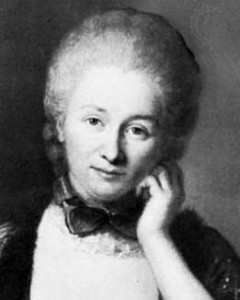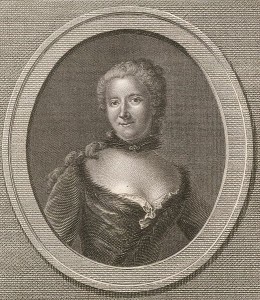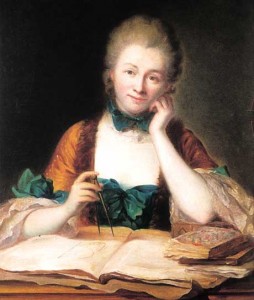- Gabrielle Émilie Le Tonnelier de Breteuil, marquise du Châtelet (1706-1749), French mathematician and physicist
- Portrait of Emilie du Châtelet
- Madame Du Châtelet
Emilie Du Châtelet (1706-49) The Marquise Du Châtelet was born Gabrielle-Emilie Le Tonnelier de Breteuil in Paris on December 17, 1706.[1] Her father, Louis Nicolas le Tonnelier de Breteuil served King Louis XIV as one of the noblesse de robe, men ennobled because of service to the king, while her mother, Gabrielle-Anne de Froullay, was partially brought up in a convent, like other young French noblewomen at the time.[2] Her family was descended from an ancient family of Picardy . From a young age, Du Châtelet showed “uncommon capacity and vigor of mind.”[3] She was extremely fortunate that her father allowed her to become educated and pursue her interests in poetry, languages and mathematics, which was uncommon for girls during this period.[4] In fact, in one of the drafts of Du Châtelet’s preface to her translation of Bernard Mandeville’s Fable of the Bees (1714), Du Châtelet wrote, “If I were king, I would establish colleges for women.”[5] Although this book was banned in France, Du Châtelet was not deterred and the translation—eventually published in 1735—was her first published intellectual work.[6]
In 1725, Du Châtelet was married to the much older Florent-Claude, Marquis Du Châtelet-Lomont who was “a touch dull but decent–and unbothered by his brainy wife’s intellectual and amorous adventures.”[7] The match, deemed very appropriate by both families, was most likely viewed as a “business deal,” typical for noble marriages.[8] Du Châtelet seems to have been content with the union, saying once, “Happily, I am sure of m. du [Du Châtelet], he is the most respectable and estimable man I know.”[9] Du Châtelet had three children with her husband, a daughter and two sons; she would later dedicate her Institutions de physique to her elder son, inscribing “Good luck, my son, raise your eyes to the stars” on the title page.[10] Du Châtelet stayed with her husband for five years, traveling with him as his military and political career took him around the country, but in 1730 Du Châtelet returned to Paris where she continued her intellectual pursuits and led a busy social life.[11] In 1733, after having a brief affair with the Duc de Richelieu, “the most sought-after man in France,” she became the lover of Francois-Marie Arouet de Voltaire , who recognized her outstanding talents for mathematics and science.[12] He was “the love of her life and its great intellectual and cultural stimulus.”[13]
Due in part to her relationship with Voltaire, Du Châtelet gave up some of her socializing and her more frivolous habits and embarked on a detailed, private study of mathematics, instructed by Pierre-Louis Moreau de Maupertuis . It was Maupertuis who first introduced Du Châtelet to the ideas of Isaac Newton.[14] This transition from a Parisian socialite to a student in rural France was a major rite of passage for Du Châtelet; many of her letters from the period discuss her personal changes and her shift from one life to another.[15] In 1734, Du Châtelet offered Voltaire sanctuary at her chateau in Champagne , since he was threatened with arrest by the monarchy as a results of his criticism of French political and social structure.[16] During this time, she and Voltaire created a laboratory at the chateau where they conducted experiments on light and electricity.[17] They later moved to Lorraine, where she and Voltaire welcomed intellectuals from throughout Europe and established a cultural center second only to Paris.
It was Du Châtelet who first proposed and developed the idea that light and heat were the same substance in her 1737 study entitled Dissertation sur la nature et la propagation du feu (Dissertation on the nature and propagation of heat).[18] In this study, which Voltaire arranged to be published with the winning entries of a contest organized by the Académie Royale des Sciences, Du Châtelet argued against the common theory that heat was an invisible substance. Concurrently, Du Châtelet was also working on her Institutions de physique (Institutes of Physic) a commentary and synthesis of the ideas of various philosophers of the era, particularly Isaac Newton and Gottfried Wilhelm Leibniz [19]. In Female Biography, Mary Hays credits Du Châtelet for explaining Leibniz’s ideas clearly and making them more intelligible to the public.[20] For many, however, the Institutions de physique, published in 1740, was offensive. Du Châtelet attempted to synthesize Leibnizian metaphysics with Newton’s highly scientific and materialistic worldview by stating and personally accepting that science had metaphysical foundations.[21] This rejected the mechanistic worldview of some of the most prominent philosophers of the day, causing many to respond sharply to Du Châtelet’s work. The Cartesian physicist and mathematician Jean-Jacques d’Ortous de Mairan , who had been singled out for particular criticism in Du Châtelet ’s Institutions, published a biting response in 1741 that Du Châtelet struggled to refute.[22]
Apparently worn out from the philosophical war, in the early 1740s Du Châtelet focused on studies of Newton’s work, particularly his Principia mathematica (1687), which he had written in Latin. Scholars suggest that Du Châtelet was one of the only people who could have completed the task of translating this work, as she had the unique combination of skills necessary to do so, including a deep understanding of Newtonian physics, as well as an unmatched proficiency in Latin.[23] She threw herself into the task of translating the work into French, and also making it more understandable by using calculus to express Newton’s confusing and complex geometric proofs.[24] She also extracted the “crucial implications” for the study of gravity and energy from his interconnected theorems,[25] which paved the way for the many discoveries that emerged from theoretical physics in the 19th century. Of particular note is that the use of the square for the speed of light in Einstein’s famous E=mc2 equation can be directly traced to her work in translating and interpreting the Principia mathematica.[26] The intensity with which she applied herself to the task of studying and translating Newton’s work weakened her considerably, both physically and mentally.
Although Du Châtelet and Voltaire continued to live together throughout the 1740s, later in the decade Du Châtelet began an affair with a much younger poet, Jean-Francois, Marquis de Saint-Lambert.[27] It was this affair that led to an unwanted pregnancy when Du Châtelet was 42 years old. Before giving birth, Du Châtelet worked desperately to finish her translation of the Principia mathematica, and finally succeeded. At the court of Stanislas Leszczyński, Duke of Lorraine, she gave birth to a daughter on September 4, 1749, and died of a pulmonary embolism from a complication of the birth.[28] Her husband, Voltaire, and Saint-Lambert were all by her bedside when she died. Her daughter did not live long. Voltaire wrote a preface to her Principes Mathématiques de la Philosophie Naturelle (Mathematical Principles of Natural Philosophy) and had it published in 1759 with the help of Maupertuis’s protégé, Alexis-Claude Clairaut, who had tutored Du Châtelet in the mid-1730s.[29] This work remains one of the greatest examples of French scholarship today.
[1] Gale Group, “Gabrielle-Emilie Le Tonnelier de Breteuil Du Châtelet,”
[2] Judith P. Zinsser, Emilie Du Châtelet: Daring Genius of the Enlightenment (New York: Penguin, 2006), 24-292.
[3] Mary Hays, Female Biography; or, Memoirs of Illustrious and Celebrated Women of all Ages and Countries (6 volumes) (London: R. Phillips, 1803), 51-4, on 51.
[4] “The woman behind the man: Love and the Enlightenment.” The Economist 85 (20 May 2006). Accessed 14 March 2014. http://www.economist.com/node/6941672.
[5] Zinsser, Emilie Du Châtelet, 25.
[6] Zinsser, Emilie Du Châtelet, 25.
[7] “The woman behind the man,” The Economist.
[8] Zinsser, Emilie Du Châtelet, 32.
[9] Zinsser, Emilie Du Châtelet, 37.
[10] Zinsser, Emilie Du Châtelet, 43.
[11] Gale Group, “Gabrielle-Emilie Le Tonnelier de Breteuil Du Châtelet.”
[12] “The woman behind the man,” The Economist.
[13] “The woman behind the man,” The Economist.
[14] Gale Group, “Gabrielle-Emilie Le Tonnelier de Breteuil Du Châtelet.”
[15] Zinsser, Emilie Du Châtelet, 97.
[16] Gale Group, “Gabrielle-Emilie Le Tonnelier de Breteuil Du Châtelet.”
[17] Hays, Female Biography, vol. 2, 51-4, on 53.
[18] Gale Group, “Gabrielle-Emilie Le Tonnelier de Breteuil Du Châtelet,”; and Zinsser, Emilie Du Châtelet, 152
[19] Judith P. Zinsser, “Marchioness de Du Châtelet,” Mary Hays, Female Biography; or, Memoirs of Illustrious and Celebrated Women, of All Ages and Countries (1803). Chawton House Library Series: Women’s Memoirs, ed. Gina Luria Walker, Memoirs of Women Writers Part II (London: Pickering & Chatto, 2013), vol. 6, 53-6, editorial notes, 414-15, on 414.
[20] Hays, Female Biography, vol.2, 51-4, on 53.
[21] Gale Group, “Gabrielle-Emilie Le Tonnelier de Breteuil Du Châtelet,”; and Hays, Female Biography, vol. 2, 51-4, on 52.
[22] Gale Group, “Gabrielle-Emilie Le Tonnelier de Breteuil Du Châtelet.”
[23] Gale Group, “Gabrielle-Emilie Le Tonnelier de Breteuil Du Châtelet.”
[24] “The woman behind the man,” The Economist.
[25] “The woman behind the man,” The Economist.
[26] “The woman behind the man,” The Economist.
[27] Encyclopædia Britannica Online, s. v. “Gabrielle-Emilie Le Tonnelier de Breteuil, marquise Du Châtelet,” Accessed March 24, 2014. http://www.britannica.com/EBchecked/topic/107923/Gabrielle-Emilie-Le-Tonnelier-de-Breteuil-marquise-du-Du Châtelet; and “The woman behind the man,” The Economist.
[28] Encyclopaedia Britannica Online, s.v. “Gabrielle-Emilie Le Tonnelier de Breteuil, marquise Du Châtelet,”; and Zinsser, “Marchioness de Du Châtelet,” vol. 6, 53-6, editorial notes 414-15, on 415.
[29] Zinsser, Emilie Du Châtelet, 72.; and Hays, Female Biography, vol.2, 51-4, on 54; and Encyclopaedia Britannica Online, s.v. “Gabrielle-Emilie Le Tonnelier de Breteuil, marquise Du Châtelet Du Châatelet,”; and Zinsser, “Marchioness de Du Châtelet,” vol. 6, 53-6, editorial notes 414-15, on 415.
Bibliography:
David Bodanis. Passionate Minds: The Great Enlightenment Love Affair. Crown, 2006.
Encyclopaedia Britannica. 15th ed., s.v. “Gabrielle-Emilie Le Tonnelier de Breteuil, marquise du Chatelet.” Chicago: Encyclopaedia Britannica, 2014.
Gale Group. “Gabrielle-Emilie Le Tonnelier de Breteuil du Chatelet.” World of Mathematics, 2006, 1-2. From Biography in Context. Accessed 3 March 2014. http://ic.galegroup.com.research.aadl.org/ic/bic1/ReferenceDetailsPage/ReferenceDetailsWindow?failOverType=&query=&prodId=BIC1&windowstate=normal&contentModules=&mode=view&displayGroupName=Reference&limiter=&currPage=&disableHighlighting=false&displayGroups=&sortBy=&search_within_results=&p=BIC1&action=e&catId=&activityType=&scanId=&documentId=GALE%7CK2426100071&source=Bookmark&u=aadl&jsid=94b75d15f8b549e36864b4baaa77fd90
Mary Hays. Female Biography; or, Memoirs of Illustrious and Celebrated Women of all Ages and Countries. 6 volumes. London: R. Phillips, 1803, 51-54.
Judith P. Zinsser. Emilie du Chatelet: Daring Genius of the Enlightenment. New York: Penguin, 2006, 24-292.
Judith P. Zinsser. “Marchioness de Chatelet.” Mary Hays, Female Biography; or, Memoirs of Illustrious and Celebrated Women, of All Ages and Countries (1803). Chawton House Library Series: Women’s Memoirs, ed. Gina Luria Walker, Memoirs of Women Writers Part II. London: Pickering & Chatto, 2013, vol. 6, 53-6, editorial notes, 414-15.
“The woman behind the man: Love and the Enlightenment.” The Economist 85, 20 May 2006. Accessed 14 March 2014. http://www.economist.com/node/6941672
Page Citation:
Elizabeth Pearce. “Emilie Du Châtelet.” Project Continua (March 23, 2015): Ver. 1, (date accessed), http://www.projectcontinua.org/emilie-du-chatelet/
Tags: Enlightenment, Essayists, Europe, Mathematicians, Scientists




I see you don’t monetize projectcontinua.org, don’t waste your traffic, you can earn extra bucks every month with new monetization method.
This is the best adsense alternative for any type of website (they
approve all sites), for more info simply search in gooogle: murgrabia’s tools
I do not know whether it’s just me or if perhaps everyone else encountering problems with your website.
It appears as though some of the text in your content are running off the screen. Can someone else please provide
feedback and let me know if this is happening
to them too? This could be a problem with my browser because I’ve
had this happen before. Many thanks